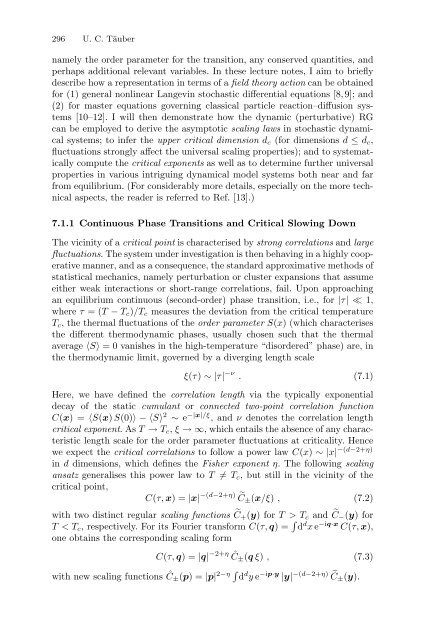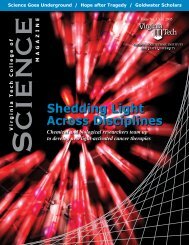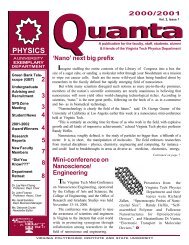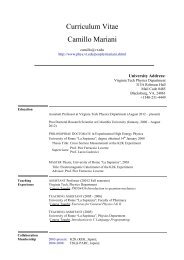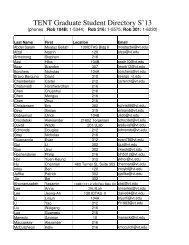Springer Lecture Notes in Physics 716
Springer Lecture Notes in Physics 716
Springer Lecture Notes in Physics 716
You also want an ePaper? Increase the reach of your titles
YUMPU automatically turns print PDFs into web optimized ePapers that Google loves.
296 U. C. Täuber<br />
namely the order parameter for the transition, any conserved quantities, and<br />
perhaps additional relevant variables. In these lecture notes, I aim to briefly<br />
describe how a representation <strong>in</strong> terms of a field theory action can be obta<strong>in</strong>ed<br />
for (1) general nonl<strong>in</strong>ear Langev<strong>in</strong> stochastic differential equations [8, 9]; and<br />
(2) for master equations govern<strong>in</strong>g classical particle reaction–diffusion systems<br />
[10–12]. I will then demonstrate how the dynamic (perturbative) RG<br />
can be employed to derive the asymptotic scal<strong>in</strong>g laws <strong>in</strong> stochastic dynamical<br />
systems; to <strong>in</strong>fer the upper critical dimension d c (for dimensions d ≤ d c ,<br />
fluctuations strongly affect the universal scal<strong>in</strong>g properties); and to systematically<br />
compute the critical exponents as well as to determ<strong>in</strong>e further universal<br />
properties <strong>in</strong> various <strong>in</strong>trigu<strong>in</strong>g dynamical model systems both near and far<br />
from equilibrium. (For considerably more details, especially on the more technical<br />
aspects, the reader is referred to Ref. [13].)<br />
7.1.1 Cont<strong>in</strong>uous Phase Transitions and Critical Slow<strong>in</strong>g Down<br />
The vic<strong>in</strong>ity of a critical po<strong>in</strong>t is characterised by strong correlations and large<br />
fluctuations. The system under <strong>in</strong>vestigation is then behav<strong>in</strong>g <strong>in</strong> a highly cooperative<br />
manner, and as a consequence, the standard approximative methods of<br />
statistical mechanics, namely perturbation or cluster expansions that assume<br />
either weak <strong>in</strong>teractions or short-range correlations, fail. Upon approach<strong>in</strong>g<br />
an equilibrium cont<strong>in</strong>uous (second-order) phase transition, i.e., for |τ| ≪1,<br />
where τ =(T − T c )/T c measures the deviation from the critical temperature<br />
T c , the thermal fluctuations of the order parameter S(x) (which characterises<br />
the different thermodynamic phases, usually chosen such that the thermal<br />
average 〈S〉 = 0 vanishes <strong>in</strong> the high-temperature “disordered” phase) are, <strong>in</strong><br />
the thermodynamic limit, governed by a diverg<strong>in</strong>g length scale<br />
ξ(τ) ∼|τ| −ν . (7.1)<br />
Here, we have def<strong>in</strong>ed the correlation length via the typically exponential<br />
decay of the static cumulant or connected two-po<strong>in</strong>t correlation function<br />
C(x) =〈S(x) S(0)〉 −〈S〉 2 ∼ e −|x|/ξ ,andν denotes the correlation length<br />
critical exponent. AsT → T c , ξ →∞, which entails the absence of any characteristic<br />
length scale for the order parameter fluctuations at criticality. Hence<br />
we expect the critical correlations to follow a power law C(x) ∼|x| −(d−2+η)<br />
<strong>in</strong> d dimensions, which def<strong>in</strong>es the Fisher exponent η. The follow<strong>in</strong>g scal<strong>in</strong>g<br />
ansatz generalises this power law to T ≠ T c , but still <strong>in</strong> the vic<strong>in</strong>ity of the<br />
critical po<strong>in</strong>t,<br />
C(τ,x) =|x| −(d−2+η) ˜C± (x/ξ) , (7.2)<br />
with two dist<strong>in</strong>ct regular scal<strong>in</strong>g functions ˜C + (y) forT>T c and ˜C − (y) for<br />
T


